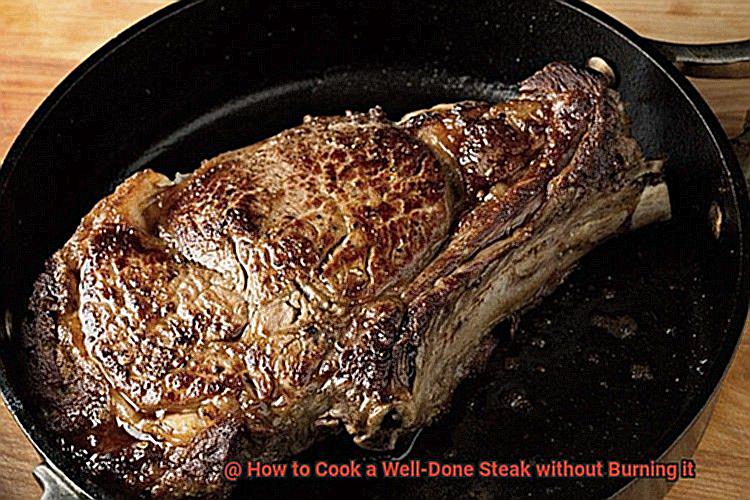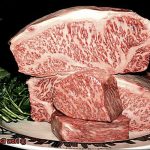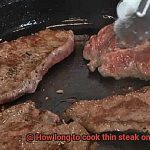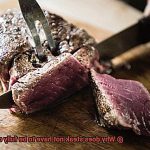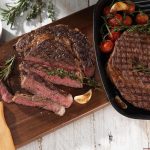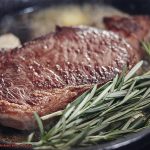Do you consider yourself a steak aficionado, but always end up with a well-done steak that’s overcooked and lacking in flavor? Fear not, my friend. We’re here to help you cook the perfect well-done steak without burning it.
Cooking a well-done steak can be quite challenging, as it’s easy to overcook and end up with a dry and tasteless piece of meat. But don’t let that discourage you from enjoying this delicious dish. With our expert tips, you’ll be able to cook a juicy and tender well-done steak that will leave your taste buds dancing.
We all know how satisfying it is to sink your teeth into a perfectly cooked steak. Whether it’s for a special occasion or just a weeknight dinner, cooking the perfect well-done steak is essential. From selecting the right cut of meat to seasoning it perfectly, we’ll guide you through every step of the process.
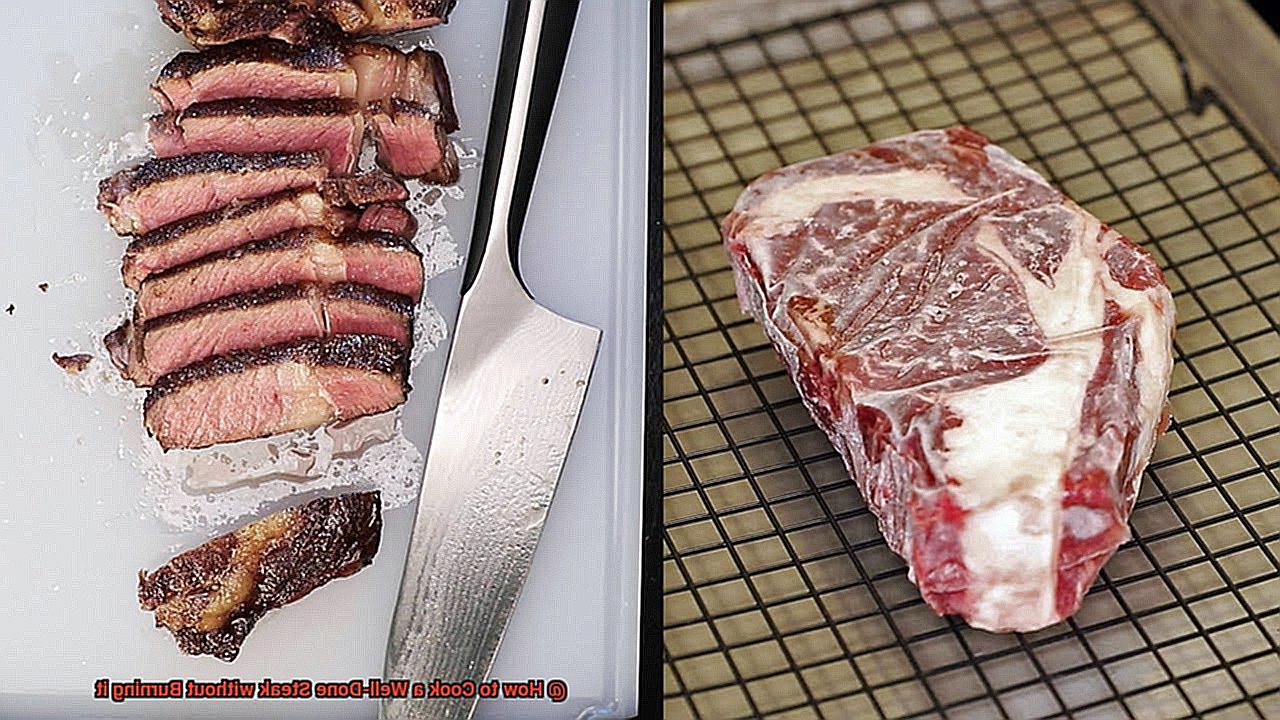
So, get ready to impress your guests with your culinary skills. In this blog post, we’ll share some amazing tips that will help you cook a mouth-watering well-done steak without burning it. By following our advice, you’ll become an expert at cooking steaks that are juicy, flavorful, and perfectly cooked every time.
Contents
Choosing the Right Cut of Meat
Choosing the perfect cut of meat for your well-done steak is like finding the right partner in life. You want someone who complements your personality and brings out the best in you. Similarly, a great cut of meat complements your cooking style and elevates the flavors of your dish.
The sirloin is one of the best cuts for a well-done steak. Coming from the rear of the cow, this lean cut is less likely to become tough or chewy when cooked to well-done.
With good marbling, it also adds an explosion of flavor and moisture to your dish, making it a top choice for any steak lover.
Another fantastic option for a well-done steak is the ribeye. This popular cut comes from the rib section of the cow and has more fat marbling than sirloin. The fat adds richness and flavor to the meat, keeping it moist and juicy even when cooked to well-done.
For those on a budget, bottom round, top round, and eye of round are great alternatives. These cuts come from the rear leg of the cow and are generally leaner than other cuts. While they can become tough if overcooked, using a meat thermometer will ensure that you cook them to the proper temperature without drying them out.
When selecting a cut of meat for a well-done steak, opt for one that is at least 1 inch thick. Thinner cuts are more challenging to cook without burning or drying out. Letting the meat come to room temperature before cooking ensures even cooking throughout.
Using a meat thermometer is crucial when cooking a well-done steak. Insert it into the thickest part of the steak and cook until it reaches an internal temperature of 160°F (71°C). This will ensure that it’s cooked through without overcooking and drying out.
To prevent burning, use a heavy-bottomed skillet or grill pan over medium-high heat with some oil or butter before adding the steak. Sear each side for 3-4 minutes until a golden brown crust forms. Adjust the heat as necessary to prevent burning or drying out.
Once the steak is seared on both sides, reduce the heat to medium-low and continue cooking until it reaches your desired doneness.
Use a spoon or tongs to baste the steak with any remaining oil or butter in the pan to add extra flavor and moisture.
Finally, let the steak rest for 5-10 minutes before slicing into it.
Bring Steak to Room Temperature
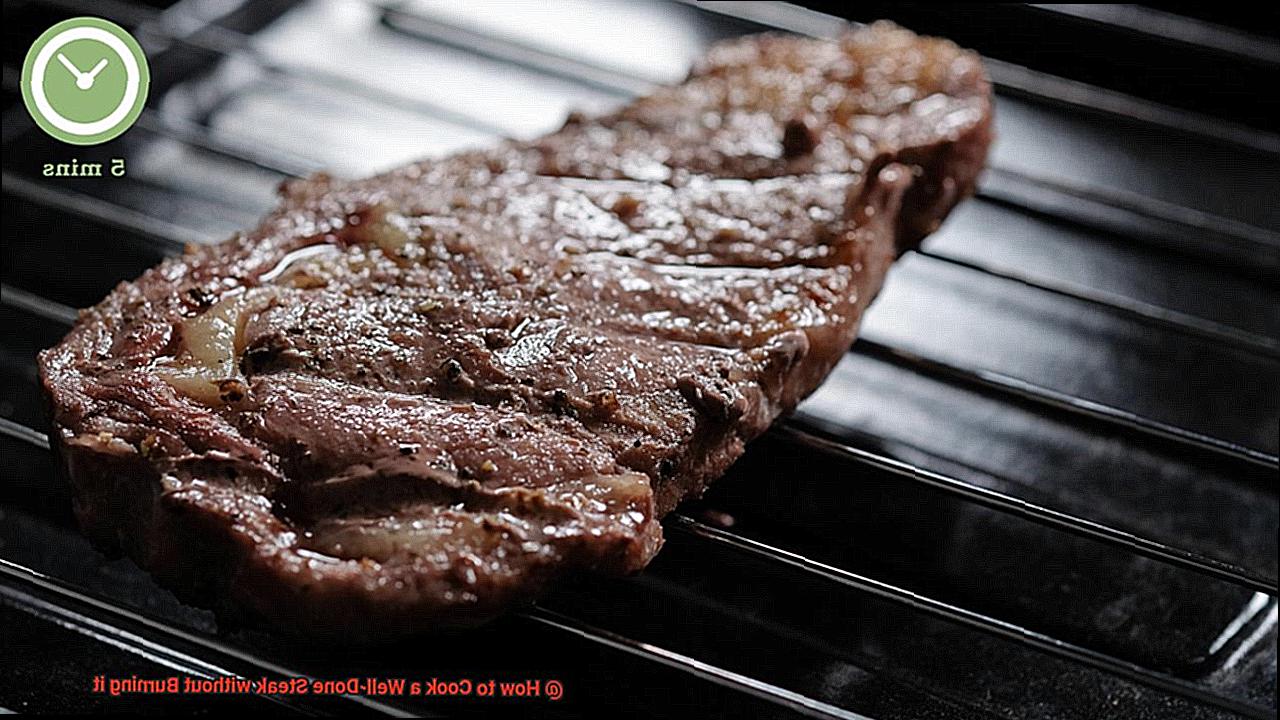
Cooking the perfect steak is an art form, and it all starts with bringing your steak to room temperature before cooking. This essential step is often overlooked, but it can make all the difference between a mediocre meal and a mouthwatering masterpiece.
When you take your steak out of the fridge, it’s like a person who has been out in the cold for too long. Just like you wouldn’t want to jump into a hot shower right away, your steak needs time to acclimate to the warmth of your kitchen. Giving it 30 minutes to an hour to relax and warm up will make it easier to cook evenly.
If you cook a cold steak straight from the fridge, you risk overcooking the outside and undercooking the inside. This can be a recipe for disaster when you’re aiming for a delectable well-done steak.
By bringing it to room temperature first, you’re allowing the heat to penetrate evenly throughout the meat, resulting in a juicy and perfectly cooked piece of heaven.
To bring your steak to room temperature, start by taking it out of its packaging and placing it on a plate. Cover it loosely with plastic wrap or foil and let it sit at room temperature for 30 minutes to an hour. If time is not on your side, submerge the steak in warm water for a few minutes to speed up the process.
It’s crucial not to leave your steak out for too long as bacteria can grow rapidly at room temperature. Aim for no more than an hour of resting time before cooking.
And don’t forget to use a meat thermometer to ensure your steak reaches an internal temperature of 160°F (71°C) before letting it rest for 5-10 minutes.
Use a Meat Thermometer
Your ultimate secret weapon for cooking a perfect well-done steak without burning it.
Before starting the cooking process, ensure that your meat thermometer is properly calibrated to get accurate readings. Insert it into the thickest part of the steak, avoiding any bones or fat. Don’t let the thermometer touch any bone as this can give false readings.
The USDA recommends different internal temperatures for different levels of doneness. For a medium-rare steak, aim for an internal temperature of 145°F; for medium, 160°F; and for well-done, 170°F to 180°F. With your trusty meat thermometer by your side, you can easily monitor the internal temperature of your steak and ensure that it reaches the desired level of doneness without overcooking it.
Using a meat thermometer takes all the guesswork out of cooking steak and ensures consistent results every time. It’s like having a loyal companion guiding you towards success in the kitchen.
Once your steak reaches its ideal internal temperature, remove it from the heat and let it rest for a few minutes before slicing and serving.
Investing in a meat thermometer is a small price to pay for perfectly cooked steaks every time. Impress your guests with juicy, mouthwatering steaks that are sure to leave them begging for more.
Cooking on the Stovetop or Grill Pan
Cooking a mouthwatering well-done steak on the stovetop or grill pan can be a challenge, but don’t worry, we’ve got you covered. With the right technique and a few key tips, you can achieve a perfectly cooked steak without burning it.
Firstly, it’s crucial to ensure that your pan or grill is hot before you start cooking. This will help sear the outside of the steak and lock in the juices, while also preventing it from sticking to the cooking surface. Imagine diving into a cool pool on a hot summer day – you want to make sure it’s ready for you.
Next, choose a thicker cut of steak such as ribeye or sirloin. These cuts can withstand longer cooking times without becoming tough or dry, making them ideal for well-done steaks. Give your steak time to reach room temperature before cooking to ensure it cooks evenly and is as tender as possible.
To prevent burning, use a high smoke point oil such as canola or vegetable oil, and apply it lightly to both sides of the steak before seasoning with salt and pepper. This is like applying sunscreen before heading out into the sun – it’ll protect your skin from burning just like the oil will protect your steak from overcooking.
Now it’s time to cook. Place the steak onto the hot pan or grill and leave it for a few minutes until a crust forms on one side. Flip the steak and repeat on the other side. Think of it like practicing your dance moves – you want to make sure both sides get equal attention.
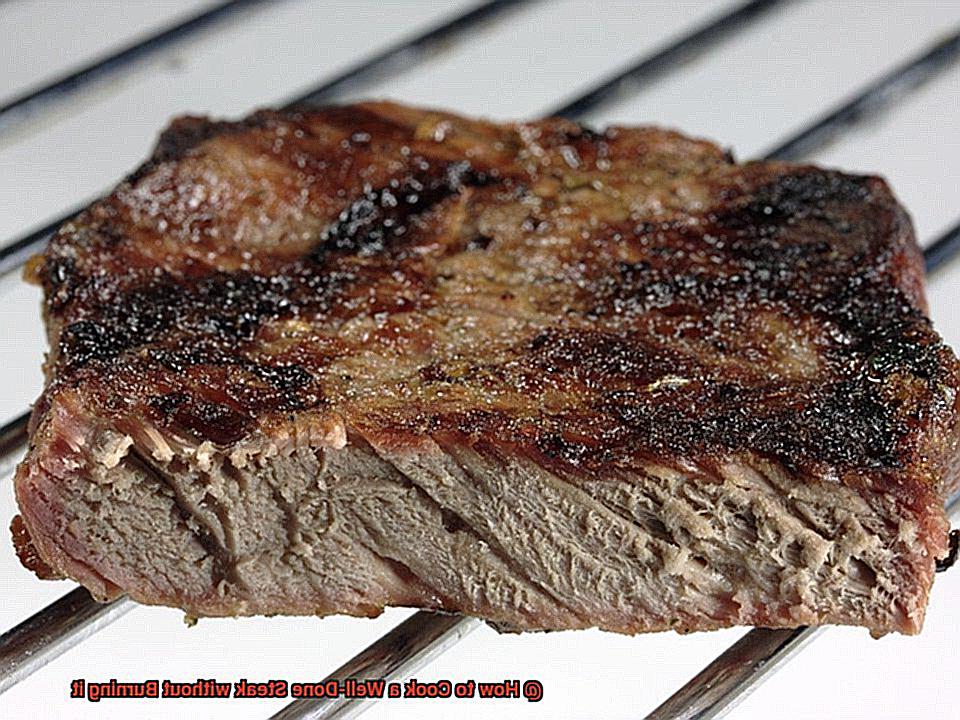
To ensure that the inside of the steak is cooked through without burning the outside, use a meat thermometer to check its temperature. For a well-done steak, aim for an internal temperature of 160-170°F (71-77°C). This is like checking your heart rate during exercise – you want to make sure everything is going smoothly.
If the steak is not quite done yet, you can finish cooking it in the oven at 350°F (175°C) until it reaches your desired temperature. This is like giving a cake a few more minutes in the oven to make sure it’s fully baked.
Finally, let the steak rest for a few minutes before slicing into it. This will allow the juices to redistribute throughout the meat and result in a more tender and flavorful steak. It’s like taking a break after a workout – you need time to recover and enjoy the fruits of your labor.
Monitoring Heat and Adjusting as Necessary
Cooking a perfect well-done steak can be a daunting task, but mastering the art of monitoring heat and adjusting as necessary is the key to achieving a delicious, tender, and juicy steak with a delectable crust.
To begin with, using a meat thermometer is essential in ensuring that your steak is cooked to perfection without burning it. Aim for an internal temperature of 160°F for a well-done steak.
The type of grill or pan used plays a crucial role in monitoring heat. While gas grills are easy to use and maintain consistent temperature, charcoal grills require more attention and adjustments to ensure that the heat is even throughout the cooking process. Cast iron pans are also great for cooking steaks as they can distribute heat evenly, resulting in a perfectly cooked steak.
When cooking a well-done steak, it’s important to avoid searing it at high heat for too long as this can lead to burning.
Start by searing the steak on high heat for a short amount of time on each side before lowering the heat and continuing to cook until it reaches the desired internal temperature. This will give your steak a sumptuous crust while maintaining tenderness and juiciness.
Basting with Oil or Butter
If you’re looking to cook a well-done steak without burning it, this technique is your perfect solution. Let’s explore how you can elevate your cooking game with this simple yet effective method.
Basting with oil or butter is a popular method that adds flavor, moisture, and tenderness to your steak. The oil or butter creates a protective barrier between the steak and the cooking surface, ensuring that the meat stays juicy and succulent. It’s a great way to help your steak cook evenly and avoid burning.
Choosing the right oil is crucial to successful basting. Look for oils with a high smoke point, such as vegetable, canola, or grapeseed oil. These oils can withstand high heat without burning and creating a charred flavor on the steak. Alternatively, you can use clarified butter or ghee, which have a nutty, rich flavor and a higher smoke point than regular butter.
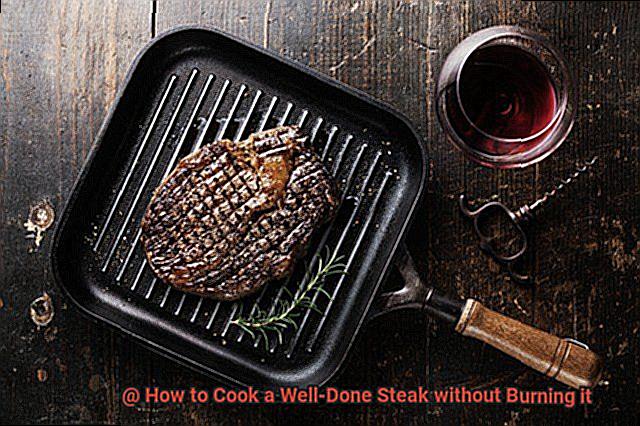
To baste your steak with oil or butter, use a pastry brush or spoon to apply it evenly over the surface of the meat. Be creative and experiment with different flavors by adding herbs like thyme, rosemary, or sage to your oil or butter mixture for an extra boost of taste.
When basting with oil or butter, it’s important to work quickly and carefully to avoid losing too much heat from the cooking surface. Baste your steak every few minutes while it cooks to keep it moist and flavorful.
And don’t forget to let it rest for a few minutes before slicing into it – this allows the juices to redistribute throughout the meat for maximum juiciness.
Letting the Steak Rest
Cooking a steak is like running a marathon. The heat causes the juices inside to move towards the surface, just like how your heart pounds and your muscles ache after running a long distance. So, just like how you slow down and catch your breath after a race, your steak needs time to recover and redistribute its juices before you start slicing into it.
For many people, cutting into their steak right after it comes off the heat is a common mistake. This can cause all those delicious juices to escape onto your cutting board, leaving you with a dry and tough piece of meat. But if you let your steak rest for a few minutes, those juices will redistribute throughout the meat, resulting in a more tender and flavorful steak.
To let your steak rest properly, remove it from the heat source and place it on a cutting board or plate. Let it rest for at least five minutes, or aim for ten minutes for a thicker cut of steak. Tenting your steak with foil during this time will help keep it warm while it rests.
But did you know that your steak will continue to cook during the resting period? That’s right. If you want a well-done steak, you should remove it from the heat source when it’s still slightly undercooked.
The internal temperature of the meat will increase by a few degrees during resting, resulting in a perfectly cooked well-done steak.
Slice and Serve
Now comes the final step – slicing and serving it to perfection. This is where your culinary skills really shine, as each slice can make or break the texture and flavor of the meat.
To start, make sure you have a sharp knife on hand. Cutting against the grain of the meat is crucial for achieving tenderness and chewiness. If you’re unsure of the direction of the grain, look for the lines in the meat and slice perpendicular to them.
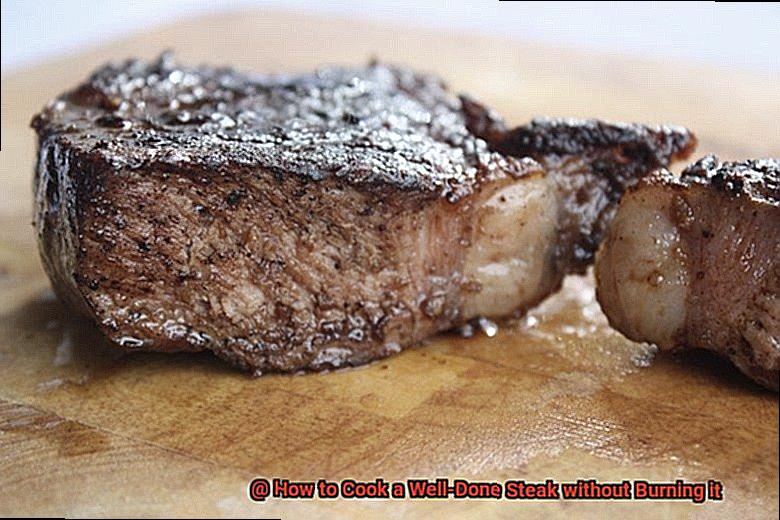
But hold off on slicing right away. Let your steak rest for a few minutes to allow its juices to redistribute throughout the meat. This will help retain its moisture and flavor, and prevent it from becoming dry and tough. For an extra layer of decadence, add a pat of butter on top of the steak while it rests.
Now it’s time to plate up your masterpiece. Don’t forget about presentation – adding some chopped herbs or lemon wedges as garnish can elevate the dish and enhance its flavor. And don’t forget to pair your steak with your favorite sides such as roasted vegetables or mashed potatoes for a complete meal.
You can cook a well-done steak without burning it and savor a mouth-watering and satisfying meal. It’s like crossing the finish line of a marathon – all your hard work has paid off and now you get to enjoy the fruits of your labor.
3pzREMzPXgg” >
Conclusion
In conclusion, cooking a perfectly well-done steak without burning it may seem challenging, but with the right techniques and tips, you can achieve a mouth-watering and satisfying meal. It all starts with selecting the right cut of meat, seasoning it just right, monitoring heat levels, and making necessary adjustments along the way.
Using a meat thermometer to check for doneness is crucial to avoid overcooking or undercooking your steak. Basting with oil or butter while cooking can help keep the steak moist and flavorful. Additionally, letting your steak come to room temperature before cooking ensures even cooking throughout.
When it comes to choosing the right cut of meat, thicker cuts like ribeye or sirloin are ideal for achieving tenderness and juiciness. To cook your perfect well-done steak, use a heavy-bottomed skillet or grill pan over medium-high heat with some oil or butter before adding the steak. Sear each side for 3-4 minutes until a golden brown crust forms, then reduce the heat to medium-low and continue cooking until it reaches your desired doneness.
The final step is allowing your steak to rest for at least five minutes before slicing into it. This allows its juices to redistribute throughout the meat resulting in a more tender and flavorful steak.

